A Nice Little Niche
Over the past couple of years, I have had the opportunity to rehab – repair, restore and re-paint – some decoys made and sold by L L Bean’s. These cork birds – originally the work of George Soule – have a real charm and have stood the test of time. Many gunners want to keep them in service and cannot simply keep them in original “paint”. Any paint wears over time, eyes fall out, bills, tails and “chines” break and crumble, and – most important – the cork can lose its seal and start to absorb water. All of these problems are easily solved with a bit of attention to detail. I always enjoy putting any gear back into service – much more satisfying than simply buying new.
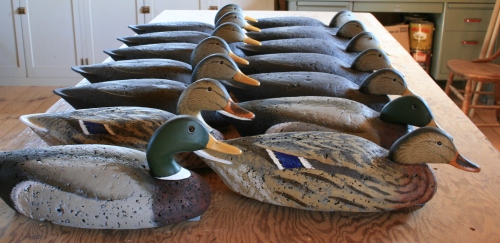
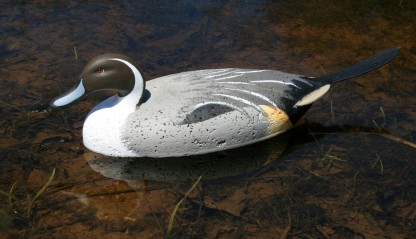
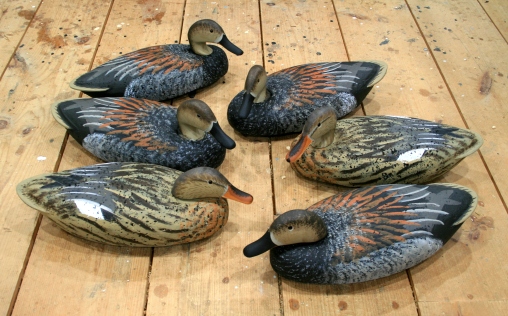
Thus far, I have rehabbed Mallards, Black Ducks, Gadwalls and a single Pintail. Three Hen Pintails and 5 Teal await my attention on the bench.
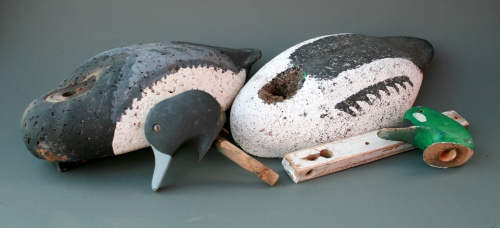
“Before”
The owner of these two birds – a Drake Whistler (Goldeneye) and Broadbill (Scaup) – wanted both made into Drake Whistlers. They arrived carefully packed but in pieces.
Gallery 1 – Repairs

1 – The socket in the head was very loose – so I used a 5/8″ Forstner bit in my drill press to bore a deeper socket to receive a new length of 5/8″ dowel.

2 – The new dowel was set in marine epoxy thickened with U S Composites fairing mix – microballoons and fumed silica. I taped the shaft to keep the mix off the exposed part.

3 – The same thickened epoxy was used to bed the keel and to fill the hole through the body. The cellophane tape kept the dowel from sticking so a nice 5/8″ hole was molded into the body.

4 – Other imperfections in the bodies were filled at the same time.

5 – The tail boards were sealed with straight epoxy, brushed on.

7 – I like to round over the corners and edges of the keels to prevent future damage to paint on other decoys. The taped dowel creates the hole in the epoxy fill.

6 – After curing, I carved out the “landing area” on the body so the head would seat properly.

8 – Here are the heads ready for installation. Each dowel was cut about 1/8″ short of flush – so the new screws would pull the heads down tight. And, the bodies and heads have been sealed with spar varnish before assembly.

9 – I use a paintable silicon caulk to bed the heads and the hardware.

10 – Stainless fender washers and longer panhead screws replace the original galvanized.
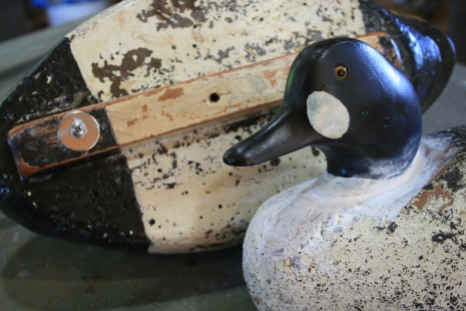
11 – All caulk is wiped or smoothed before it cures.
The Paint
I usually follow this sequence for gunning birds: 1) Seal with spar varnish. 2) Prime with flat oil-based paint. 3) Topcoat with acrylic latex (house paint). Because these birds are mostly just Black and White, however, I used flat oils for topcoats as well as prime coats. The heads got a little bit of latex for their finish.
Gallery 2 – Painting

1 – I like Grey for bottoms because it’s clean-looking and allows the owner to write their name in permanent marker.

2 – Although I normally use an oil-based primer, this product allows for oil or latex over it. I brought the Grey up to cover the undertail area to serve as a topcoat.

3 – Flat White is most of the body. Be sure to carry it around behind the head onto the back.

4 – Carry it up onto the lower neck and paint in the oval between the eye and the bill.

5 – The White goes up into the scapulars and the secondaries.

6 – Note how the side feathers angle back to a point – not rounded like in most other ducks.

7 – The secondaries – speculum – are marked in pencil.

8 – Note how the side pockets are lower forward and higher aft.

9 – I use an angle brush to demarcate the White areas from the Black.

10 – Note the curve at the after edge of the side pockets. Carry the Black down onto the Grey undertail.

11 – The Black back comes to a point on the shoulders while leaving a narrow band of White showing behind the head – at least when the head is upright.

12 – The White oval on the face is immediately behind the bill and below and in front of the eye. I was tempted to replace the eyes with bright new ones – with pinpoint pupils – but opted for the originals since all 4 were sound and secure.

13 – Lay out 7 scapulars with pencil. Each gets longer and wider as you go aft.

14 – I use a 1/4″ angle brush to paint in the edges of the scapulars.

15 – I curve them downward – but they can also sweep backward.

16 – Now add the upper edges of the side feathers – with the same brush.

17 – These are ready to hunt – but I will tart up the heads a bit.

18 – Few Whistler stool enjoyed any green paint before recent decades. But, I mixed a Medium Green – Home Depot Pastoral – with Flat Black to make a very dark base coat.

19 – Once the base dried, I used a beat up #10 Filbert brush to stipple on the Pastoral along the aft edges of the face.

20 – Here is the Pastoral dried.

21 – Finally, I used tube acrylic and the same brush to stipple on the highlights.

22 – I put a final coat of White on the oval.
Every Girl Crazy for a Sharp-dressed Man
The suggestion of iridescence is guaranteed to provide the gunner with an extra thrill – each time he picks up the rig.
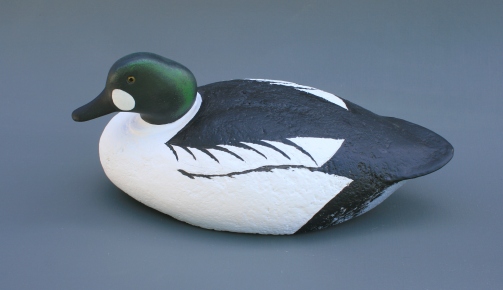
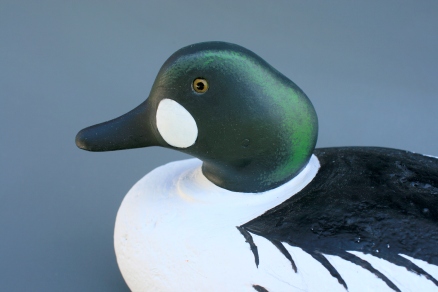
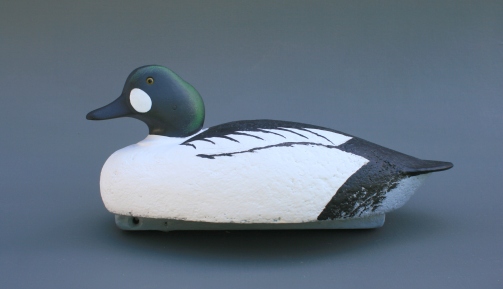
All the best!
SJS











































Nice one, enjoyed seeing the studio workshop on the tour, all cleaned up and everything priced out.
Andrew Andrew Pate 896 County Route 60 Greenwich, NY 12834 518-692-7676 518-232-9247
They are outstanding!
Sent from my iPhone
>
Mr. Sanford, you have inspired me to rehab 2 LL Bean black ducks that deserve to get back into the action. I sealed them with spar and will begin to paint this weekend.
Bruce Hudson
Limestone, NY